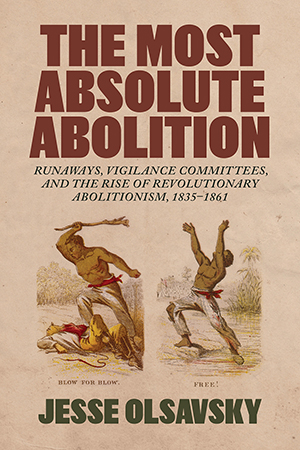
304 pages / 6.00 x 9.00 inches / 6 halftones
History / United States - 19th Century | History / United States - Civil War Period | Social Studies / Slavery Studies
Jesse Olsavsky’s The Most Absolute Abolition tells the dramatic story of how vigilance committees organized the Underground Railroad and revolutionized the abolitionist movement. These groups, based primarily in northeastern cities, defended Black neighborhoods from police and slave catchers. As the urban wing of the Underground Railroad, they helped as many as ten thousand refugees, building an elaborate network of like-minded sympathizers across boundaries of nation, gender, race, and class.
Olsavsky reveals how the committees cultivated a movement of ideas animated by a motley assortment of agitators and intellectuals, including famous figures such as Frederick Douglass, Harriet Tubman, and Henry David Thoreau, who shared critical information with one another. Formerly enslaved runaways—who grasped the economy of slavery, developed their own political imaginations, and communicated strategies of resistance to abolitionists—serve as the book’s central focus. The dialogues between fugitives and abolitionists further radicalized the latter’s tactics and inspired novel forms of feminism, prison reform, and utopian constructs. These notions transformed abolitionism into a revolutionary movement, one at the heart of the crises that culminated in the Civil War.
Jesse Olsavsky is assistant professor of history at Duke Kunshan University in China.
Faculty web page: https://scholars.duke.edu/person/jesse.olsavsky
“This engaging and meticulously researched book offers the first comprehensive look at how runaways and former maroons were both the drivers and teachers of the radical abolition movement through their work with vigilance committees. Jesse Olsavsky shines a new and revealing light on the extraordinary courage, heroism, and vision of the thousands who delivered themselves from bondage and those who assisted them.”—Sylviane A. Diouf, author of Slavery’s Exiles: The Story of the American Maroons
“Jesse Olsavsky has written the most original work on the Underground Railroad. A brilliant and theoretically ambitious book that unearths the abolitionist underground. This important history of fugitivity, resistance, and their long afterlives is a cut above the rest.”—Manisha Sinha, author of The Slave’s Cause: A History of Abolition
“A significant historiographic intervention. In a deeply researched and analyzed study of abolitionist Vigilance Committees, Olsavsky reveals an urban, radical Black politics driven by refugees and their allies on the Underground Railroad. The result was a community-based revolutionary abolitionism with lessons for today.”—Graham Russell Gao Hodges, author of David Ruggles: A Radical Black Abolitionist and the Underground Railroad in New York City
“This stirring history of the self-defense of the emancipated reveals the effectiveness of direct action. Filled with arresting sources, judiciously analyzed, it is a most important study of how social movements work.”—David Roediger, author of Seizing Freedom: Slave Emancipation and Liberty for All
“The Most Absolute Abolition provides readers with a fascinating perspective on vigilance committees and their role in shaping and organizing instances of abolitionism before and during the Civil War. . . . the compelling nature of the narrative, combined with Olsavsky’s diligent research and clear writing style, make this a book that both seasoned and novice historians can consume.”—Louisiana History
Found an Error? Tell us about it.